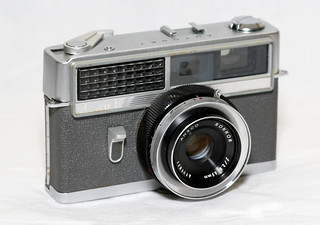Difference between revisions of "Minolta Hi-Matic"
(noting overlaps with Uniomat; two footnotes which somewhat debunk the John Glenn "Ansco from the drugstore" myth) |
(→Links) |
||
| (16 intermediate revisions by 6 users not shown) | |||
| Line 1: | Line 1: | ||
| + | |||
{{Flickr_image | {{Flickr_image | ||
|image_source= http://www.flickr.com/photos/captkodak/271906449/in/pool-camerawiki | |image_source= http://www.flickr.com/photos/captkodak/271906449/in/pool-camerawiki | ||
| − | |image= http://farm1.static.flickr.com/99/ | + | |image= http://farm1.static.flickr.com/99/271906449_b4338ed633.jpg |
|image_align= right | |image_align= right | ||
|image_text= Standard-setting 1962 rangefinder | |image_text= Standard-setting 1962 rangefinder | ||
| Line 7: | Line 8: | ||
|image_rights= non-commercial | |image_rights= non-commercial | ||
}} | }} | ||
| − | The '''Minolta Hi-Matic''' | + | The '''Minolta Hi-Matic''' cameras redefined [[Minolta]]'s series of budget [[rangefinder camera]]s, although they overlapped with the less-advanced [[Minolta Uniomat|Uniomat II]] and [[Minolta Uniomat|Uniomat III]]. The Hi-Matics always had a fully-automatic exposure mode. |
| + | |||
| + | The original Hi-Matic model controlled this via a [[selenium meter]], and offered a flash mode with shutter speed 1/30 sec. and manual aperture control. This model became famous in its [[Ansco]] OEM version, the '''Ansco Autoset''', as one of the cameras that Astronaut John Glenn used during his 1962 Mercury space flight<REF>The Ansco was modified by NASA with a pistol grip and optics to make UV spectrographs, not pictorial images: [https://airandspace.si.edu/collection-objects/camera-35mm-glenn-friendship-7/nasm_A19670198000 "Camera, Spectrographic, 35mm, Glenn, Friendship 7"] in the collection of the [http://www.nasm.si.edu/ Smithsonian National Air and Space Museum].</REF><REF> Glenn used a modified Leica for pictorial images: [https://airandspace.si.edu/stories/editorial/another-journey-john-glenn%E2%80%99s-ansco-camera "Another Journey for John Glenn’s Ansco Camera"] (May 27, 2011) blog post from [http://blog.nasm.si.edu/ Smithsonian National Air & Space Museum].</REF>. | ||
Later Hi-Matics had [[CdS]] meters (beginning with the [[Minolta Hi-Matic 7|Hi-Matic 7]]), with the meter cell always placed within the filter ring. | Later Hi-Matics had [[CdS]] meters (beginning with the [[Minolta Hi-Matic 7|Hi-Matic 7]]), with the meter cell always placed within the filter ring. | ||
| − | |||
===Specifications=== | ===Specifications=== | ||
* Type: rangefinder camera | * Type: rangefinder camera | ||
* Manufacturer: [[Minolta]] | * Manufacturer: [[Minolta]] | ||
| − | * Year of launch: | + | * Year of launch: 1961<ref> The Ansco model was [https://www.flickr.com/photos/camerawiki/52553940752/in/pool-camerawiki/ advertised in the November, 1961, ''Popular Photography''] (Vol. 49, No. 5; inside front cover).</ref> |
* Film: 35mm with speeds from 6 to 1600 ASA | * Film: 35mm with speeds from 6 to 1600 ASA | ||
* Lens: 1:2.0/45mm (6 elements in 5 groups) | * Lens: 1:2.0/45mm (6 elements in 5 groups) | ||
| Line 22: | Line 24: | ||
* Size: 138×84×67 mm | * Size: 138×84×67 mm | ||
* Weight: 740 g | * Weight: 740 g | ||
| + | |||
| + | |||
===Later variant=== | ===Later variant=== | ||
* Lens: 1:2.8/45mm (4 elements) | * Lens: 1:2.8/45mm (4 elements) | ||
| − | |||
| − | |||
| − | |||
| − | |||
| − | |||
| − | |||
{{Flickr_image | {{Flickr_image | ||
|image_source= http://www.flickr.com/photos/maderik/4801615872/in/pool-camerawiki | |image_source= http://www.flickr.com/photos/maderik/4801615872/in/pool-camerawiki | ||
| − | |image= http://farm5.static.flickr.com/4076/ | + | |image= http://farm5.static.flickr.com/4076/4801615872_4d5076412b_n.jpg |
| − | |image_align= | + | |image_align= right |
|image_text= As [[Ansco]] Autoset | |image_text= As [[Ansco]] Autoset | ||
|image_by= edjpgcom | |image_by= edjpgcom | ||
|image_rights= cc | |image_rights= cc | ||
}} | }} | ||
| + | |||
| + | |||
| + | ==Notes== | ||
| + | <references/> | ||
| + | |||
| + | ==Links== | ||
| + | *[http://progsch.net/mediawiki2/index.php?title=Hi-Matic Hi-Matic] in [http://progsch.net/mediawiki2 Minowiki] (German) | ||
| + | * [https://butkus.org/chinon/minolta.htm Minolta Hi-Matic (and several variations) PDF manual(s)] from [https://butkus.org/chinon/ OrphanCameras.com] | ||
[[Category:Minolta|Hi-Matic]] | [[Category:Minolta|Hi-Matic]] | ||
| − | [[Category:H|Hi-Matic]] | + | [[Category:H|Hi-Matic Minolta]] |
[[Category:Japanese 35mm rangefinder]] | [[Category:Japanese 35mm rangefinder]] | ||
| + | [[Category:1961]] | ||
Latest revision as of 16:50, 4 February 2023

|
| Standard-setting 1962 rangefinder image by Steve Harwood (Image rights) |
The Minolta Hi-Matic cameras redefined Minolta's series of budget rangefinder cameras, although they overlapped with the less-advanced Uniomat II and Uniomat III. The Hi-Matics always had a fully-automatic exposure mode.
The original Hi-Matic model controlled this via a selenium meter, and offered a flash mode with shutter speed 1/30 sec. and manual aperture control. This model became famous in its Ansco OEM version, the Ansco Autoset, as one of the cameras that Astronaut John Glenn used during his 1962 Mercury space flight[1][2].
Later Hi-Matics had CdS meters (beginning with the Hi-Matic 7), with the meter cell always placed within the filter ring.
Contents
Specifications
- Type: rangefinder camera
- Manufacturer: Minolta
- Year of launch: 1961[3]
- Film: 35mm with speeds from 6 to 1600 ASA
- Lens: 1:2.0/45mm (6 elements in 5 groups)
- Shutter: Citizen leaf shutter with meter-controlled aperture/speed combinations from f2 1/45 sec. to f16 1/500sec
- Metering: selenium meter
- Size: 138×84×67 mm
- Weight: 740 g
Later variant
- Lens: 1:2.8/45mm (4 elements)

|
| As Ansco Autoset image by edjpgcom (Image rights) |
Notes
- ↑ The Ansco was modified by NASA with a pistol grip and optics to make UV spectrographs, not pictorial images: "Camera, Spectrographic, 35mm, Glenn, Friendship 7" in the collection of the Smithsonian National Air and Space Museum.
- ↑ Glenn used a modified Leica for pictorial images: "Another Journey for John Glenn’s Ansco Camera" (May 27, 2011) blog post from Smithsonian National Air & Space Museum.
- ↑ The Ansco model was advertised in the November, 1961, Popular Photography (Vol. 49, No. 5; inside front cover).